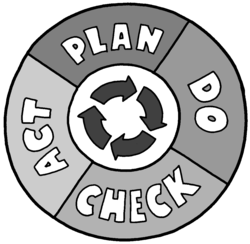No matter how big the CEO’s desk is, an organization is not a hierarchy. It…
Dance with the System
An organization is a complex adaptive system. It will adapt to what you do, so you must adapt continuously to how the system responds. This is reflected in the words inspect and adapt, used frequently in Agile literature.
But… adaptation is not enough. If you only adapt to the system, it means the system is always in the lead. People who never lead a system are merely following where it’s going! And thus, as a change agent, you have to augment adaptation with anticipation and experimentation. Or, in the words of systems thinker Donella Meadows…
“We can't control systems or figure them out. But we can dance with them!”
– Donella Meadows, Thinking in Systems
Early system thinking
 This is not new. In fact, some of the earliest system thinkers, W. Edwards Deming and Walter A. Shewart, already described this principle many decades ago. Their PDCA model was developed by Shewhart in the early 1920’s and made popular by Deming in the early 1950’s.
This is not new. In fact, some of the earliest system thinkers, W. Edwards Deming and Walter A. Shewart, already described this principle many decades ago. Their PDCA model was developed by Shewhart in the early 1920’s and made popular by Deming in the early 1950’s.
PDCA, which stands for Plan, Do, Check, Act, is an iterative four-step management process. Any change management initiative consists of a sequence of interventions in a system (or its environment), where you check the effects the interventions have on the system. When your actions work as intended, you move on to the next step. When they don’t work, you try some other ones. It is a never-ending cycle of setting goals (Plan), implementing ideas (Do), measuring feedback (Check) and analyzing results (Act).
In his keynote at the XP2011 conference Brian Marick showed us that working with a system is not unlike dancing the tango. Dancing with a system is about leading and following. It is an ongoing cycle of planning a direction, making a step, sensing the response, and evaluating success. It combines anticipation, experimentation, and adaptation. (For Lasse Koskela and me it was a very tangible metaphor.)
The scientific method
The concept of PDCA is based on the scientific method of hypothesis, experimention and evaluation. PDCA is a powerful tool, because it is simple. And, because of the constant feedback cycle, there are many opportunities to adjust your plans and to reach your goals or to adjust your goals when they appear to be wrong.
Especially in the case of inexperienced dancers, dealing with the inevitable results of going in the wrong direction, standing on your partner’s feet, or colliding with another couple, is for many people the most challenging aspect of change management.
There’s just one remedy… Keep dancing.
(Image by prayitno)





